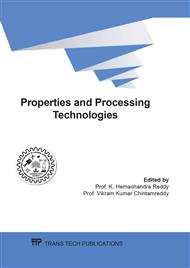[1]
Sukhatme S.P. Solar Energy Principles of Thermal Collection and Storage,, Tata McGraw-Hill publishing company limited, 2nd edition, 1984; 1-30.
Google Scholar
[2]
K.P. Sibin, Siju john, Control of thermal emittance of stainless steel using sputtered tungsten thin films for solar thermal power application, Elsevier, Solar Energy Materials and Solar Cells, 2015; 133, 1-7.
DOI: 10.1016/j.solmat.2014.11.002
Google Scholar
[3]
M. Vila, D. Caceres, C. Prieto Mechanical properties of sputtered silicon nitride thin films, Journal of Applied Physics, 2003; 94 (12), 7868-7873.
DOI: 10.1063/1.1626799
Google Scholar
[4]
P. Quintana, A. I. Oliva, O. Ceh and J. E. Corona Thickness effects on alumina thin films, Superficies y, December 1999; 9, 280-282.
Google Scholar
[5]
A. Antonaia, A.Castaldo, M.L. AddonizioS.Esposito Stability of W-Al2O3 Cermet Based Solar Coating for Receiver Tube Operating at High Temperature, Solar Energy Materials and Solar Cells, 2010; 94, 1604-1611.
DOI: 10.1016/j.solmat.2010.04.080
Google Scholar
[6]
Muralidhar Singh M, Vijay G, Krupashankara M S and R S Kulkarni Effect of Argon Gas Flow Rate on the Optical and Mechanical Properties of Sputtered Tungsten Thin Film Coatings, Materials Science and Engineering, 2016;149,.
DOI: 10.1088/1757-899x/149/1/012075
Google Scholar
[7]
X.H. Gao, Z.M. Guo, Q.F. Geng, P.J. Ma Enhanced Absorptance of Surface-Textured Tungsten Thin Film for Solar Absorber, Journal of Surface Engineering, 2016; 32, 840-845.
DOI: 10.1080/02670844.2016.1187466
Google Scholar
[8]
Barshilia, Harish C,Sibin, K P and Siju, John Control of Infrared Emittance of Stainless Steel using Sputtered W Thin Films for Solar Thermal Applications, Solar Energy Materials and Solar Cells, 2015; 133, 921-927.
DOI: 10.1016/j.solmat.2014.11.002
Google Scholar
[9]
Ali Abdolahzadeh Ziabari, A. BagheriKhatibani Optical Properties and Thermal Stability of Solar Selective Absorbers Based on Co–Al2O3 Cermets, Chinese Journal of Physics, 2017; 55, 876-885.
DOI: 10.1016/j.cjph.2017.02.015
Google Scholar
[10]
Neelakanta Reddy Alumina Thin films Sputtered using Pulsed RF Magnetron Sputtering Method,, Ceramics International, 2014; 39, 89-194.
Google Scholar
[11]
M. Farooq, Z. H. Lee Optimization of the Sputtering Process for Depositing Composite Thin Films, Journal of the Korean Physical Society, March 2002; 40 (3), 511-515.
Google Scholar
[12]
C. Paturaud, G. Fages, M. C. Sainte Catherine, J. Machet Influence of sputtering gases on the properties of magnetron sputtered tungsten film, Elsevier, Surface and Coatings 1996; 388-393.
DOI: 10.1016/s0257-8972(96)02954-4
Google Scholar
[13]
Arjun Dey, Anoop S, Parthasarathi Bera, Uma Rani Corrosion behaviour of sputtered alumina thin films, Springer, Journal of Institute of Engineers, India, Series. D, May 2015;.
DOI: 10.1007/s40033-015-0072-x
Google Scholar
[14]
Ivan Martinez, Rafeal Almanza, Marcos Mazari Genaro Correa Parabolic trough reflector manufactured with aluminium first surface mirrors thermally sagged, Elsevier, Solar Energy Materials, 2000, Vol. 64. 85-96.
DOI: 10.1016/s0927-0248(00)00068-4
Google Scholar
[15]
Y.L. Jeyachandran, B. Karungaran, Sa. K. Narayandass, D. Mangalaraj, T.E Jenkins, P.J. Martin Properties of Ti thin films deposited by DC Magnetron sputtering, Elsevier, Material Sci. and Engg., 2006; 431, 277-284.
DOI: 10.1016/j.msea.2006.06.020
Google Scholar
[16]
Xiang-Hu Gao, Cheng-Bing Wang, Zhi-Ming Guo, Qing-Fen Geng, Wolfgang Theiss, Gang Liu Structure, optical properties and thermal stability of Al2O3 -WC nanocomposite ceramic spectrally selective solar absorbers, Elsevier, Optical Materials, 58 (2016) 219-225.
DOI: 10.1016/j.optmat.2016.05.037
Google Scholar
[17]
Montgomery Douglas C Design and Analysis of Experiments,, New Delhi, Wiley India (P) Ltd, 2007; 4.
Google Scholar
[18]
Volkonen E, Karlsson B. Optimization of metal-based multilayers for transparent heat mirrors, International Journal of Energy Research, 1987; 11(3), 397-403.
DOI: 10.1002/er.4440110309
Google Scholar
[19]
M.K. Olsson, K.K Macak, U. Helmersson and B. Hjorvarsson. High rate recative DC magnetron sputter deposition of Al2O3 films, Journal of vacuum science technology, March 1998; A 16 (2).
DOI: 10.1116/1.581081
Google Scholar
[20]
M.S. Aouadi, R.R. Parson, P.C. Wong, K.A.R Mitchell, Characterization of sputter deposited tungsten films for X-ray multilayers, Journal of vacuum science technology, 1992; A 102, 273-280.
DOI: 10.1116/1.578075
Google Scholar
[21]
D.B. Mahadik, S. Gujjar, G.M. Gouda, H.C. Barshilia, Double layer SiO2/Al2O3 high emissivity coatings on stainless steel substrates using simple spray deposition system, Appl. Surf. Sci. 2014; 299, 6-11.
DOI: 10.1016/j.apsusc.2014.01.159
Google Scholar


